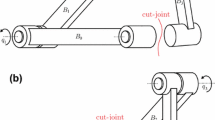Abstract
An integrated method for symbolical derivation of Eqs and numerical computations using dual numbers for analysis of spatial mechanisms is presented in this paper. The formulation is based on 3×3 dual transformation matrices and derived symbolically using the MathematicaTM software package. Based on the solution procedure presented in this paper, a software library of functions for displacement analysis of spatial mechanisms has been developed. Functions in this software library can be readily used in theC H language environment, where dual number is treated as a first-class object. Displacement analysis of the RCRCR spatial mechanisms is used as an example to illustrate the solution procedure and programming details.
Similar content being viewed by others
References
Soni, A.H.; Harrisburger, L. (1988) Die Anwendung der 3C Schraubungs Matrix auf die kinematische und dynamische Analyse von Raumliche Getrieben. V.D.I. Berichte, 127.
Yang, A.T. (1969) Displacement analysis of spatial five-link mechanisms using (3×3) matrices with dual-number elements. J. Engineering for Industry, 91, 152–157.
Ravani, B.; Roth, B. (1984) Mappings of spatial kinematics. ASME Trans. J. Mechanisms, Transmissions, and Automation in Design, 106, 341–347.
Pennock, G.R.; Yang, A.T. (1985) Application of dual number matrices to the inverse kinematic problem of robot manipulators. ASME Trans. J. Mechanisms, Transmissions, and Automation in Design, 107, 201–208.
McCarthy, M. (1996) Introduction to Theoretical Kinematics. MIT Press, Cambridge, MA.
Denavit, J.; Hartenberg, R. S. (1955) A kinematic notation for lower pair mechanisms based on matrices. ASME Trans. J. Applied Mech., 22, 215–221.
Suh, C.H.; Radcliffe, C.W. (1978) Kinematics and Mechanism Design, Wiley, NY.
Yuan, S.C. (1970) Analysis of the RCRCR five-link spatial mechanism. J. Mechanisms, 6, 119–134.
Denavit, J. (1958) Displacement analysis of mechanisms based on (2×2) matrices of dual numbers. VDI-Berichte, 29, 81–89.
Hamilton, W.R. (1889) Elements of Quarternions, 2nd ed. C.J. Jolly (ed.), Vol. 1, 1899; Vol. 2, 1901. Longmans, Green and Co., London.
Yang, A.T.; Freudenstein, F. (1964) Application of dual number quaternions algebra to the analysis of spatial mechanisms. ASME J. Applied Mechanics, 31 (Trans. ASME, 86 (2), 300–308).
Cheng, H.H. (1993) Scientific Computing in the CH Programming Language. Scientific Programming, 2 (3), 49–75.
Cheng, H.H. (1997) The CH Language Environment. http://iel.ucdavis.edu/CH.
Cheng, H.H. (1994) Programming with dual numbers and its applications in mechanisms design. Engineering with Computers, 10 (4), 212–229.
Wolfram, S. (1991) Mathematica, A system for doing mathematics by computer. Addison-Wesley, 2nd ed.
Cheng, H.H.; Thompson, S. (1995) Computer-aided displacement analysis of spatial mechanisms using the CH programming language. Advances in Engineering Software, 23, (3), 163–172.
Gonzalez, P. (1996) A Software Library for Displacement Analysis of Spatial Mechanisms. MS Thesis, University of California, Davis, CA.
Author information
Authors and Affiliations
Rights and permissions
About this article
Cite this article
Cheng, H.H., Gonzalez, P. Development of a software library of functions for analysis of spatial mechanisms. Engineering with Computers 14, 156–167 (1998). https://doi.org/10.1007/BF01213590
Issue Date:
DOI: https://doi.org/10.1007/BF01213590




